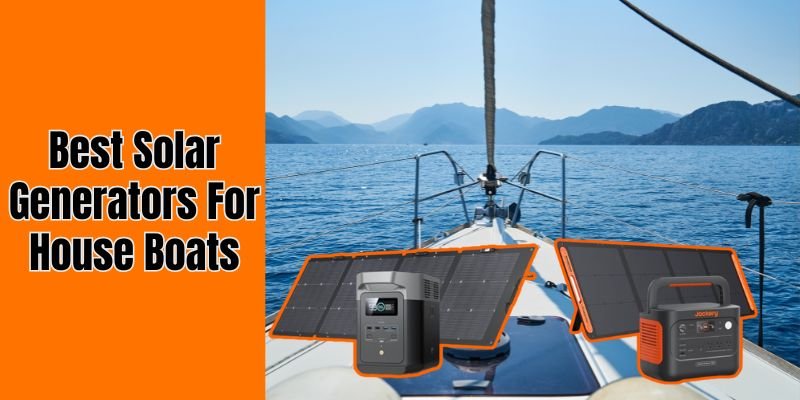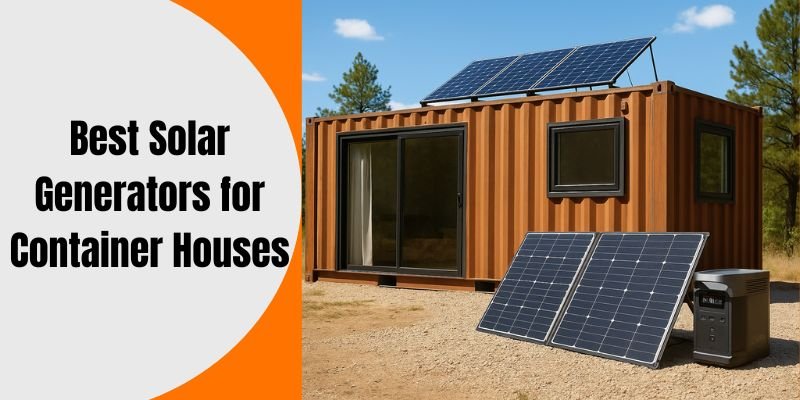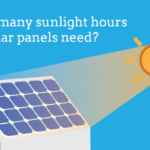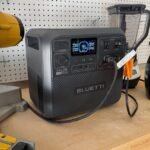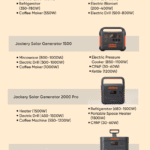Disclosure: This post contains affiliate links and I will be compensated if you make a purchase after clicking through my links. Learn More
To run a house with a solar generator, you need the right size. The size depends on your power needs and usage.
Solar generators are a great way to provide clean energy. They can power everything from lights to appliances. But how do you know what size you need? It’s important to consider your household’s energy consumption. Different homes have different power needs.
Some might need a small system, while others require a larger one. This guide will help you understand how to choose the right size solar generator for your house. By the end, you’ll know exactly what to look for and how to make the best decision for your home.
Introduction To Solar Generators
Switching to solar energy is a smart move for homeowners looking to reduce their carbon footprint and energy bills. But what size solar generator do you need to run a house? Before diving into the specifics, let’s get acquainted with solar generators. Understanding how they work and their benefits will help you make an informed decision.
Benefits Of Solar Energy
Solar energy is renewable and sustainable. By harnessing the power of the sun, you can reduce your reliance on fossil fuels. This means lower electricity bills and a smaller carbon footprint.
Another significant benefit is energy independence. With a solar generator, you aren’t at the mercy of power outages. This can be especially crucial in areas prone to natural disasters or grid failures.
Solar energy systems are also low maintenance. Once installed, they require minimal upkeep. This ensures a hassle-free, long-term solution to your energy needs.
Why Choose A Solar Generator?
Solar generators are versatile and efficient. They can power your entire house or just essential appliances. This flexibility is a big plus for many homeowners.
Unlike traditional gas generators, solar generators are quiet and clean. No more noisy, polluting engines disturbing your peace.
They are also portable. Whether you’re camping, traveling, or just need backup power, a solar generator can be a reliable companion. This portability adds an extra layer of convenience to your energy setup.
When my family switched to a solar generator last year, we were amazed at the savings on our utility bills. Plus, the peace of mind knowing we had a reliable backup during storms was invaluable.
So, what size solar generator do you need to run a house? The answer will depend on your energy consumption, the size of your home, and your specific needs. But with the right information, you can make a choice that benefits both your wallet and the planet.
Assessing Your Energy Needs
When planning to run your house on a solar generator, the first step is to assess your energy needs. Without understanding how much energy your household consumes, you risk either overspending on an excessively large system or underpowering your home. Let’s break this down step by step.
Calculating Daily Energy Consumption
Start by calculating your daily energy consumption. This involves adding up the wattage of each appliance you use and multiplying it by the number of hours you use it daily. For instance, if your fridge uses 150 watts and runs 24 hours a day, it consumes 3,600 watt-hours per day.
Take a look at your electricity bill. It often lists your monthly usage in kilowatt-hours (kWh). Divide this by 30 to get a rough estimate of your daily consumption. This number will help you understand your baseline energy needs.
Remember, it’s not just about adding up numbers. Think about how often you run each appliance. Do you use the washing machine daily, or just once a week? Adjust your calculations accordingly to get a realistic picture.
List Of Essential Appliances
Consider which appliances are essential. Some items are non-negotiable, like your fridge, lights, and perhaps a few fans. Others might be luxury items you can do without during a power shortage.
Make a list of your must-have appliances. Include their wattage and estimated hours of use. Here’s a simple example:
- Refrigerator: 150W, 24 hours – 3,600 watt-hours
- LED Lights: 10W each, 5 hours – 50 watt-hours per light
- Fan: 70W, 8 hours – 560 watt-hours
- Laptop: 60W, 4 hours – 240 watt-hours
Add up these numbers to see your total daily consumption. This helps you determine the capacity your solar generator needs. It’s a straightforward process that gives you valuable insight into your energy habits.
Ask yourself, can you reduce usage or swap high-consumption appliances for energy-efficient models? Small changes can significantly lower your overall energy needs, making your solar generator more effective and cost-efficient.
By carefully assessing your energy needs, you set the foundation for a solar power system that truly fits your lifestyle. It’s all about smart planning and realistic expectations.
Types Of Solar Generators
When deciding on the size of a solar generator to run your house, it’s crucial to understand the different types available. Each type has unique benefits that can significantly impact your energy efficiency and lifestyle. Let’s delve into some of the most common types of solar generators.
Portable Vs. Stand-alone Systems
Portable solar generators are compact and easy to transport. They are perfect for camping trips, RVs, or emergency backup power at home. Most portable units come with built-in batteries and can be charged via solar panels, wall outlets, or car chargers. See our best value pick.
On the other hand, stand-alone systems are designed to provide a more permanent solution. These are typically larger and can power an entire home. Stand-alone systems often require installation by professionals and are best suited for those looking for a long-term energy solution.
Consider your specific needs. Do you need a mobile power source or a more permanent installation? Your answer will guide you toward the right choice.
Grid-tied Vs. Off-grid Options
Grid-tied solar generators are connected to the local utility grid. This means you can draw power from the grid when solar energy is insufficient and feed excess solar energy back into the grid. It’s a great way to ensure you always have power and potentially reduce your electricity bills.
Off-grid systems are entirely independent of the utility grid. They rely solely on solar power and typically include large battery banks to store energy for use at night or during cloudy days. These systems are ideal for remote locations where connecting to the utility grid is not feasible.
Think about your location and energy needs. Are you in a remote area or a place with a reliable utility grid? Your situation will determine whether a grid-tied or off-grid system is more suitable.
Choosing the right type of solar generator involves assessing your lifestyle, location, and energy requirements. By understanding the differences between portable and stand-alone systems, as well as grid-tied and off-grid options, you can make an informed decision that meets your needs.
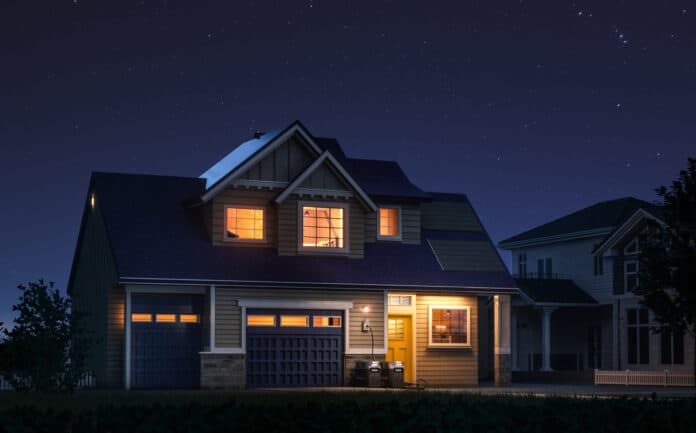
Key Features To Consider
Consider battery capacity and power output for your solar generator. Assess energy needs to ensure adequate supply. Evaluate portability and ease of installation.
When considering a solar generator for your house, it’s crucial to understand the key features that will ensure it meets your energy needs. The right generator will not only keep your home running smoothly but also maximize efficiency and savings. Below are the essential features you need to examine.
Battery Capacity
Battery capacity is a critical factor. It determines how much energy your solar generator can store. A larger battery capacity means you can run more appliances for longer periods.
Think about your daily energy consumption. Calculate the watt-hours (Wh) you use on an average day. This will help you choose a battery that can handle your needs. For instance, if your home uses 5000Wh per day, aim for a battery with at least that capacity.
Inverter Size
The inverter size is another crucial feature. The inverter converts the DC power stored in your batteries to AC power, which your home appliances use.
You need to ensure the inverter can handle the peak load of your household. If you plan to run multiple high-wattage appliances simultaneously, a larger inverter is necessary. For example, running a fridge, air conditioner, and washing machine together requires a robust inverter.
Solar Panel Efficiency
The efficiency of your solar panels affects how quickly your battery will charge. Higher efficiency panels generate more power in less time, even in lower light conditions.
Look for panels with high efficiency ratings. Quality panels typically range between 15% to 22% efficiency. Investing in efficient panels means you can generate more power with fewer panels, saving space and potentially reducing costs.
By focusing on these key features, you can ensure your solar generator will meet your needs. Make informed choices to enjoy the benefits of reliable, sustainable power for your home.
Sizing Your Solar Generator
Choosing the right size solar generator for your house is crucial. It ensures you have enough power to meet your needs. There are several factors to consider. Let’s break it down step by step.
Understanding Wattage Requirements
First, you need to understand your home’s wattage requirements. Start by listing all the appliances and devices you use. Check each item’s wattage. This information is usually on the device or in its manual.
Add up the wattages to get a total. This gives you a baseline for how much power you need. Remember, some appliances use more power when starting up. Factor this into your calculations.
Matching Generator Size To Your Needs
Once you know your total wattage, match it to a generator’s capacity. Solar generators come in various sizes. Choose one that can handle your peak power needs. It’s wise to pick a generator with a little extra capacity. This ensures it can handle unexpected power spikes.
Also, think about the generator’s portability. Larger generators provide more power but may be harder to move. Balance power needs with ease of use. This ensures you get the best fit for your lifestyle.
Installation And Setup
Determining the right size solar generator for your home involves assessing power needs. Calculate the total wattage of essential devices. Choose a generator that can handle the combined load, ensuring uninterrupted power.
When considering the installation and setup of a solar generator for your home, there are several important factors to keep in mind. This process is not just about placing panels on your roof; it involves careful planning, proper execution, and safety measures. Let’s dive into the key aspects that will help you get started on the right foot.
Diy Vs. Professional Installation
Deciding whether to install your solar generator system yourself or hire a professional can be a tough choice. If you have some technical skills and enjoy hands-on projects, a DIY installation might be appealing.
However, professional installation ensures that everything is set up correctly and efficiently. When I installed my own system, I quickly realized the complexity involved with wiring and positioning the panels.
Also, professionals can help with permits and inspections, which can be a hassle if you’re unfamiliar with the process. Consider your confidence and technical ability before making a decision.
Safety Tips
Safety should be your top priority during installation. Working with electrical components and on rooftops can be dangerous. Always turn off power sources before starting any electrical work.
Use proper safety gear such as gloves, safety glasses, and non-slip shoes. I once skipped wearing gloves, and the sharp edges of the panels gave me a nasty cut.
Ensure your ladder is stable and someone is there to assist you. Follow the manufacturer’s guidelines meticulously. Remember, it’s better to ask for help than to risk injury or faulty installation.
Taking these steps and considering the DIY vs. professional installation, you’ll be better prepared for a successful solar generator setup.
Cost And Budgeting
Understanding the costs and budgeting needed for a solar generator is crucial. It helps you make an informed decision. Let’s break down the expenses involved.
Initial Investment
The initial investment in a solar generator depends on several factors. These include the size of your house and energy needs. Larger homes with higher energy consumption will need bigger systems. This means more solar panels and a larger battery capacity. The cost will be higher. High-quality solar generators can range from a few hundred to several thousand dollars.
Consider installation costs too. Professional installation ensures safety and efficiency. This adds to the initial expense but is worth it. Calculate the total cost to understand the financial commitment.
Long-term Savings
Investing in a solar generator offers long-term savings. You reduce or eliminate monthly electricity bills. This can save you a significant amount over time. Solar generators have low maintenance costs. They require minimal upkeep compared to traditional power sources.
Many regions offer incentives for solar energy use. These include tax credits and rebates. Such incentives can reduce the overall cost. Think of the long-term benefits. Savings on energy bills and incentives make the initial investment worthwhile.
Maintenance And Troubleshooting
Maintaining your solar generator ensures it runs smoothly and efficiently. Regular maintenance can extend its lifespan. Troubleshooting common issues helps prevent unexpected failures. Below are key maintenance tips and solutions to common problems.
Routine Maintenance Tips
Keep the solar panels clean. Dust and debris can block sunlight. Use a soft brush and water. Avoid harsh chemicals. Check battery connections regularly. Loose connections can reduce efficiency. Tighten any loose connections. Inspect cables for wear and tear. Replace damaged cables immediately. Ensure ventilation around the generator. Good airflow prevents overheating. Test the generator monthly. Make sure it starts and runs properly.
Common Issues And Solutions
If your generator won’t start, check the battery. It may need charging. If it’s fully charged, inspect the cables. Replace any damaged ones. If the output is low, clean the solar panels. Dirt can reduce power generation. Check for shading issues. Nearby trees or buildings can block sunlight. If the generator shuts down unexpectedly, it may be overheating. Check the ventilation. Ensure the area around the generator is clear. If problems persist, consult a professional.
Real-life Examples
Consider a family using a 5000-watt solar generator to power essential appliances. Another household with fewer devices might need only a 3000-watt system. Usage depends on the number and type of appliances.
When deciding on the size of a solar generator needed to run a house, real-life examples can provide valuable insights. Understanding how others have successfully powered their homes with solar generators can help you make an informed decision. Let’s dive into some real-life scenarios that highlight different requirements and outcomes.
Case Studies
Consider the Smith family, living in a modest 3-bedroom house. They opted for a 5000-watt solar generator. This setup powers their essential appliances like the refrigerator, washing machine, and lights. They also have enough capacity to charge their laptops and phones.
On the other hand, the Johnsons reside in a larger 5-bedroom home. They chose a 10,000-watt generator to accommodate their higher energy needs. This system supports their HVAC system, kitchen appliances, and home office equipment. The Johnsons can even run their electric car charger without any issues.
User Testimonials
Jane from Arizona shares, “Our 6000-watt solar generator has been a game-changer. We no longer worry about power outages, and it easily handles our daily usage.” Jane’s experience shows that even in a sunny state with high energy needs, a mid-range generator can be very effective.
Tom from Oregon says, “I started with a 3000-watt system for my tiny home. It covers all my basic needs, including heating, cooking, and lighting. I’m thrilled with the low maintenance and high efficiency.” Tom’s testimonial highlights how smaller setups can be perfect for those with minimal energy requirements.
These real-life examples underline the importance of assessing your specific needs before choosing a solar generator. What works for one household might not be suitable for another. So, what are your home’s energy priorities? Understanding these will guide you to the right solar generator size.
Choosing the right size solar generator for your house can be challenging. There are many factors to consider. By understanding your energy needs, you can make an informed decision.
Final Thoughts
A solar generator can be a great investment. It offers a sustainable way to power your home. To find the right size, you need to assess your power usage. Calculate the total wattage of appliances and devices. This helps you determine the capacity required.
Remember, larger generators provide more power but cost more. Smaller ones are cheaper but may not meet all your needs. Balance is key. Consider both your budget and energy demands.
Expert Tips For Choosing The Right Generator
First, list all essential appliances and devices. Include lights, refrigerator, and heating systems. Note their wattage. Sum up the total to get a rough estimate.
Second, consider peak usage times. Some appliances use more power during certain periods. Make sure your generator can handle these peaks.
Third, think about future needs. Your power demands may increase over time. Choose a generator that can accommodate growth.
Fourth, consult professionals. They can provide valuable insights. An expert can help you choose the best generator for your home.
Finally, check reviews and ratings. Learn from others’ experiences. Reliable brands usually have better performance and durability.
Frequently Asked Questions
What Size Solar Generator To Run Whole House?
A whole house solar generator typically needs a capacity of 10,000 to 20,000 watts. This ensures it can power essential appliances and systems. Make sure to assess your home’s energy needs for accurate sizing.
Can A Solar-powered Generator Run A Whole House?
Yes, a solar-powered generator can run a whole house, depending on the system’s capacity and energy consumption. Ensure the generator meets your home’s power needs.
What Can I Run With A 2000 Watt Solar Generator?
A 2000 watt solar generator can power small appliances like laptops, lights, TVs, fans, and some kitchen devices. It can also charge smartphones, tablets, and other small electronic devices. Usage depends on the appliance’s wattage and the generator’s battery capacity.
How Much Solar Power Is Needed To Run A House?
A typical house needs 5-6 kilowatts of solar power. This depends on location, energy usage, and roof space. Consult a professional for precise calculations.

